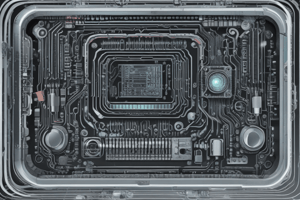Podcast
Questions and Answers
What is the major function of device communication in an I/O module?
What is the major function of device communication in an I/O module?
- Detects and reports transmission errors
- Coordinates the flow of traffic between internal resources and external devices
- Performs the needed buffering operation to balance device and memory speeds
- Involves commands, status information, and data (correct)
Which function of an I/O module involves command decoding, data, status reporting, and address recognition?
Which function of an I/O module involves command decoding, data, status reporting, and address recognition?
- Processor communication (correct)
- Error detection
- Data buffering
- Control and timing
What is the primary purpose of data buffering in an I/O module?
What is the primary purpose of data buffering in an I/O module?
- Performs the needed buffering operation to balance device and memory speeds (correct)
- Detects and reports transmission errors
- Involves command decoding, data, status reporting, address recognition
- Coordinates the flow of traffic between internal resources and external devices
In programmed I/O, what does the processor issue to an I/O module to execute the instructions?
In programmed I/O, what does the processor issue to an I/O module to execute the instructions?
How is each I/O device connected through I/O modules identified?
How is each I/O device connected through I/O modules identified?
What is the key characteristic of memory-mapped I/O?
What is the key characteristic of memory-mapped I/O?
What is the role of each I/O module in programmed I/O?
What is the role of each I/O module in programmed I/O?
Flashcards are hidden until you start studying
Study Notes
I/O Module Functions
- The major function of device communication in an I/O module is to facilitate data exchange between the processor and external devices.
- The function of an I/O module that involves command decoding, data, status reporting, and address recognition is referred to as control and interface.
Data Buffering
- The primary purpose of data buffering in an I/O module is to hold data temporarily while it is being transferred between the processor and external devices.
Programmed I/O
- In programmed I/O, the processor issues a command or instruction to an I/O module to execute the instructions.
- The role of each I/O module in programmed I/O is to manage the data transfer between the processor and external devices.
I/O Device Identification
- Each I/O device connected through I/O modules is identified by a unique address.
Memory-Mapped I/O
- The key characteristic of memory-mapped I/O is that the I/O devices are treated as if they were part of the memory, and the processor uses the same instructions to access both memory and I/O devices.
Studying That Suits You
Use AI to generate personalized quizzes and flashcards to suit your learning preferences.




